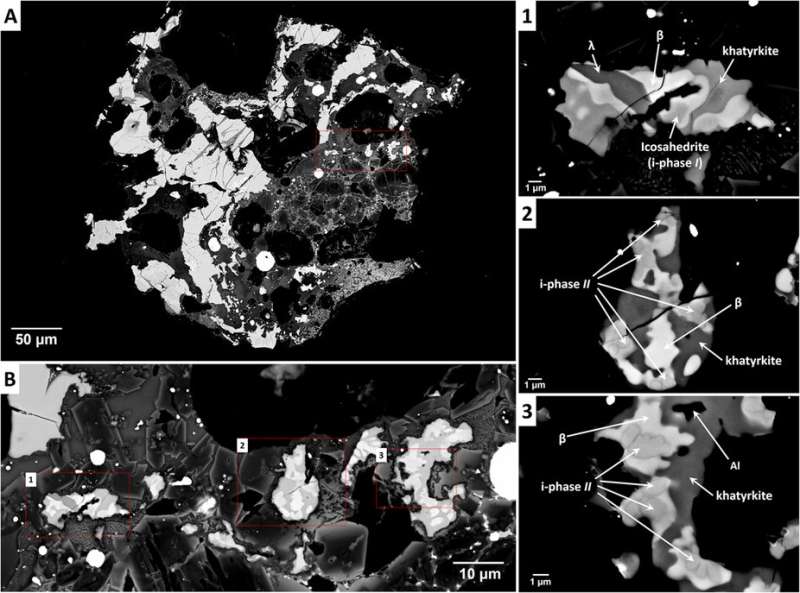December 9, 2016 report
Khatyrka meteorite found to have third quasicrystal

(Phys.org)—A small team of researchers from the U.S. and Italy has found evidence of a naturally formed quasicrystal in a sample obtained from the Khatyrka meteorite. In their paper published in the journal Scientific Reports, the team describes how they found the quasicrystal and offer some possible explanations on how it was formed.
Prior to the 1980's, scientists believed there were just two types of solids; crystals and amorphous solids. Crystals are materials made of atoms that are joined in a repeating lattice. Amorphous solids are rather the opposite, having no real order. But then researchers discovered that another type of structure could exist, at least theoretically—quasicrystals. They are made of latticed atoms, like crystals, but do not repeat. After establishing their existence, researchers began making them in labs—over 100 have been created thus far. At the time, it was not clear if quasicrystals could exist naturally, though some suggested there was no reason for them not to come about under conditions similar to those used in labs—thus began a search for an example.
That search came to fruition in 2009, as a team studying samples from the Khatyrka meteorite in northeastern Russia found two examples of quasicrystals that were of the same type that had been made in the lab. In this new effort, the researchers report that they have found a third quasicrystal from the same meteorite sample, but this one has never been made artificially before—it is also very similar to one of the other two quasicrystals found in the meteorite. All three have metallic aluminum, which, the team notes, bonds well with oxygen. The newest one also has iron and copper.
Though they have no way to prove it, the researchers suggest it is possible the quasicrystals came about due to a collision between asteroids—such a violent impact would provide both the heat and energy needed to cause the unique formations. They suggest that further study of the specimens could lead to a better understanding of the early solar system. The discovery also offers fresh hope that naturally occurring quasicrystals could be found that originated on Earth.
More information: Luca Bindi et al. Collisions in outer space produced an icosahedral phase in the Khatyrka meteorite never observed previously in the laboratory, Scientific Reports (2016). DOI: 10.1038/srep38117
Abstract
We report the first occurrence of an icosahedral quasicrystal with composition Al62.0(8)Cu31.2(8)Fe6.8(4), outside the measured equilibrium stability field at standard pressure of the previously reported Al-Cu-Fe quasicrystal (AlxCuyFez, with x between 61 and 64, y between 24 and 26, z between 12 and 13%). The new icosahedral mineral formed naturally and was discovered in the Khatyrka meteorite, a recently described CV3 carbonaceous chondrite that experienced shock metamorphism, local melting (with conditions exceeding 5 GPa and 1,200 °C in some locations), and rapid cooling, all of which likely resulted from impact-induced shock in space. This is the first example of a quasicrystal composition discovered in nature prior to being synthesized in the laboratory. The new composition was found in a grain that has a separate metal assemblage containing icosahedrite (Al63Cu24Fe13), currently the only other known naturally occurring mineral with icosahedral symmetry (though the latter composition had already been observed in the laboratory prior to its discovery in nature). The chemistry of both the icosahedral phases was characterized by electron microprobe, and the rotational symmetry was confirmed by means of electron backscatter diffraction.
Journal information: Scientific Reports
© 2016 Phys.org





















